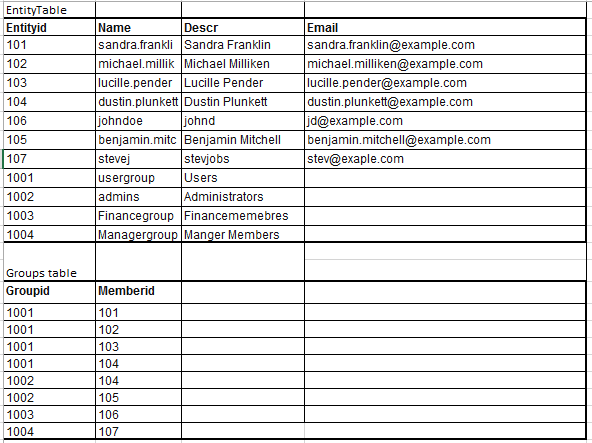Unlock a world of possibilities! Login now and discover the exclusive benefits awaiting you.
- Qlik Community
- :
- All Forums
- :
- QlikView App Dev
- :
- How to use ODBC groups in Distribute tab
- Subscribe to RSS Feed
- Mark Topic as New
- Mark Topic as Read
- Float this Topic for Current User
- Bookmark
- Subscribe
- Mute
- Printer Friendly Page
- Mark as New
- Bookmark
- Subscribe
- Mute
- Subscribe to RSS Feed
- Permalink
- Report Inappropriate Content
How to use ODBC groups in Distribute tab
hi community
i have created this ODBC user setup as per qlik help docs (https://help.qlik.com/en-US/qlikview/12.1/Subsystems/QMC/Content/QMC_System_Setup_DirectoryServicePr...)
here is my sample data in database

qmc screen

i am able to get my users in QMC
also i am able to assign these users(stevej)
in Named users in Distribute tab.
and logged with SSO aplication with username (DBDSP/stevej) its working fine(i can see qvw files in accesspoint)
Note: DBDSP\stevej(as per my DSP settings)
my requirement is to assign these odbc groups in named users( Distribute tab)
iam able to assign groups (managergroup )
odbc groups in Named users in Distribute tab and
logged with SSO application with username (DBDSP/stevej) its not working (i am not able see qvw files in accesspoint)
Note: DBDSP\stevej(as per my DSP settings), this username "stevej" is assigned to managergroup group
How can i do this with the OBDC groups?
bbtstalwar1mtoloveisfailvandith123Configurable ODBCstevedark
- Mark as New
- Bookmark
- Subscribe
- Mute
- Subscribe to RSS Feed
- Permalink
- Report Inappropriate Content
Hi,
I am also having same issue. I am able to distribute to individual user id's.But group distribution is not working.
Have you got any solution for the group distribution?
Regards,
Binu
- Mark as New
- Bookmark
- Subscribe
- Mute
- Subscribe to RSS Feed
- Permalink
- Report Inappropriate Content
I have changed Qlikview server security to DMS authorization and its working fine for me.
Thank you
Binu
- Mark as New
- Bookmark
- Subscribe
- Mute
- Subscribe to RSS Feed
- Permalink
- Report Inappropriate Content
- Mark as New
- Bookmark
- Subscribe
- Mute
- Subscribe to RSS Feed
- Permalink
- Report Inappropriate Content
Thank you.
It works with header authentication and DMS authorization.
- Mark as New
- Bookmark
- Subscribe
- Mute
- Subscribe to RSS Feed
- Permalink
- Report Inappropriate Content
Just wanted to confirm that if you are using Configurable ODBC Directory Service Provider, that you will likely need to have QlikView Server Security tab settings set to use DMS security mode in order for the group resolutions to occur properly, as if QVS is in NTFS security mode, it is relying on Windows for Authorization and resolving of users/groups. In general, most customers do also use Header Authentication method in the QVWS resource as well in these cases, as generally the reason for the Configurable ODBC DSP is due to using Oracle Authentication Manager or other DB related SSO front-ends, and they want to make use of those rather than using Windows Active Directory... Hopefully this adds a bit further clarity to things.
Regards,
Brett
I now work a compressed schedule, Tuesday, Wednesday and Thursday, so those will be the days I will reply to any follow-up posts.